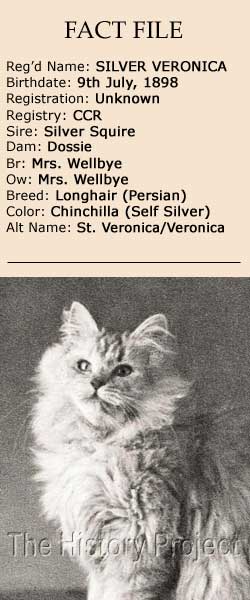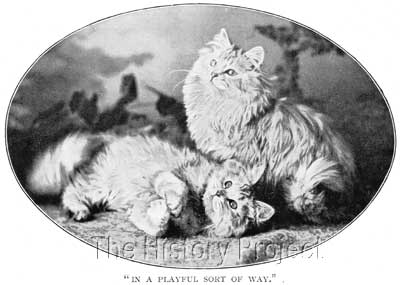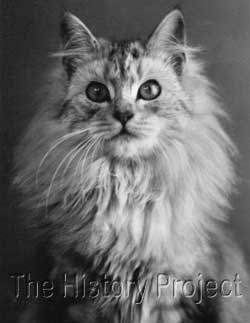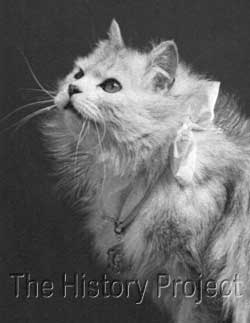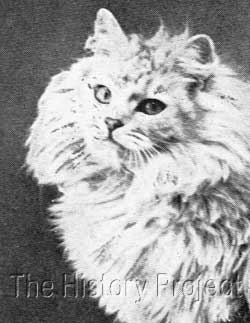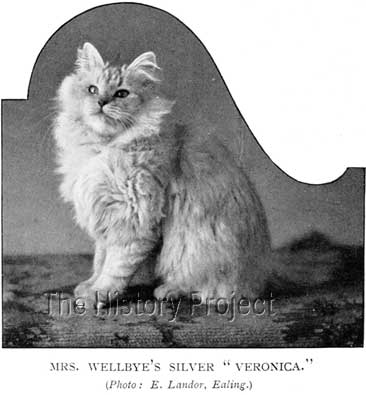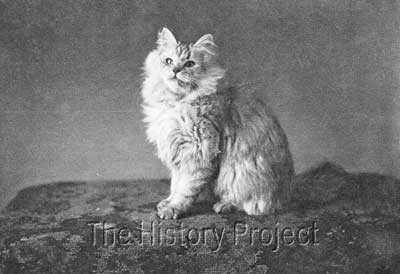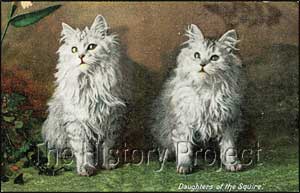 | ||||||||||||||||||||||









|
SILVER VERONICA(1898)PHOTOS | SOCIAL MEDIA | REFERENCES
HISTORICAL BACKGROUND:'Silver Veronica' (aka St.Veronica) and her litter sister 'Silver Lotus' jointly gained notoriety as 'The Daughters of The Squire'. This was during the heyday of the blossoming Silver Fanciers, when so many of them were simply attempting to breed clearer coated kittens from a plethora or foundation lines, most descended over a very short period from 'Ch. Silver Lambkin', his dam 'Beauty of Bridgeyate' or outcross lines such as 'The Nizam'. A number of breeders had also started with Silver Tabbies, and had crossed their initial lines with Smokes and early Chinchillas in the hunt for Silvers without barring. The result was a mixed bag of light Silver Tabbies, Shaded Silvers with some barring, Mask Silvers, and what was slowly but surely developing into the unique Chinchilla, but was still in essence a Shaded Silver cat with minimised barring. The goal was, for a clear-coated Silver, which was in the day, initially referred to incongruously as 'The Self Silver'. The problem was, that judges were between a rock and a hard place in defining on the day of a show, whether cat was technically a Chinchilla or a Shaded Silver, and that in itself, lead to a great deal of frustration. The dilemma, was to settle on a standard for the colour and tipping which could be applied universally by all judges. Frances Simpson relates this problem well in this quotation from Cat for Pleasure and Profit, (this from the 1909 edition): "And now for the consideration of Silvers, commonly called Chinchillas, otherwise named Shaded Silvers, and very often labelled 'Wrong Class!' To novices in the Fancy, this may sound a little mixed, so let me explain. These beautiful cats have been through stormy waters so to speak. A Specialist Society was started …for this breed, which also included Silver Tabbies and Smokes. The Silvers were divided into Self-silvers and Shaded-silvers. As however, no Self-silver has yet been born or bred, there was naturally a difficulty in filling any class set apart for these particular specimens at shows. So the lightest Silvers were considered eligible, and then came the difficulty for exhibitor and judge to draw the line between the two varieties, and to decide what degree of paleness constituted a Self-silver (so-called)and what amount of dark markings would relegate the specimen into the Shaded-silver class. Naturally it became as Silver puzzle and a Silver muddle. Exhibitors waxed wroth and judges became exasperated. Then the term 'Self-silver" was abandoned, but the endeavour to breed a Silver without any shadings or marking is still the height and ambition of many a fancier of this beautiful breed.10" PARENTAGE & OWNERSHIP:'Silver Veronica' was born on 9th July, 1898,³ in a litter of three sired by Mrs Balding's 'The Silver Squire', a Silver son of the famous 'Ch. Silver Lambkin', who was himself out of the immensely valuable, 'I, Beauty's Daughter' (from a breeding of 'The Nizam' to the dam of 'Ch.Silver Lambkin', namely 'Beauty of Bridgeyate') . Her dam was Mrs. Wellbye's singular excellent little brood queen, 'Dossie', a female Mrs. Wellbye had acquired from Lady Fitzhardinge. Having already bred 'Dossie' the previous year, directly and successfully to 'Ch. Silver Lambkin' with excellent results, in 1898, Mrs Wellbye chose to try a variation, and this time chose to breed 'Dossie' to another of Mrs. Balding's males, a son of 'Ch. Silver Lambkin' known as 'The Silver Squire'. This was a move with exceptional foresight, as 'Silver Squire' was the product of a half-brother to half-sister mating, doubling on the dam of 'Ch. Silver Lambkin' himself. When Mrs. Wellbye had bred 'Dossie' directly to 'Ch. Silver Lambkin' and produced both 'Jessamine' and 'The Silver Lily', she had simply doubled on 'Ch. Silver Lambkin's' dam, through Dossie's grandsire, 'Charlbury Silver King'. But by choosing to breed to 'Silver Squire', she was in fact choosing to TRIPLE exclusively on 'Beauty of Bridgeyate'
Eng Ch Silver Lambkin
Silver Squire, Chinchilla
| Unknown
Silver Veronica, Jul-09-1898, Chinchilla, F
| Mr. York
Dossie, Chinchilla
May
SIBLINGS & SHOWS:From this breeding came two more females and a male, the females being photographed extensively by E.Landor, (Ealing), both as kittens and young cats and who became well known simply as "the daughters of The Squire". The male was registered as 'Lucifer', but although he is listed under Mrs. Wellbye's name, there are no photographs extant and no records of any progeny from him. Both females however, were shown very successfully as can be attested to by the commentary of Frances Simpson in The Book of the Cat (1903) in which she states: ".....which may also be said of those of Mrs Wellbye, whose 'Silver Lotus' and 'Veronica,' daughters of 'Silver Squire' and 'Dossie,' did so much winning in their day."1 However, the only registry records for 'Veronica' are those in The Cat Club Register,3 and unlike the listing in the National Cat Club Register, this does not include wins at shows. So the only wins we have on record are those of her sibling 'Silver Lotus', which are indicative, and are as follows:
Postcards of both exist, separately and together as kittens and cats along with their associated nicknames. 'Silver Veronica' (aka St.Veronica), is the probably the least publicly known of 'Dossie's 'daughters' and the least photographed, but she appears on the postcards jointly with her more recognisable sister. Head-wise, they are strikingly similar, but just as 'Silver Lily' was lighter than her litter sister 'Jessamine', so too was 'Silver Lotus', lighter than her littermate 'Silver Veronica'. The difference however was not quite as extreme in this litter, from 'The Silver Squire'. However, it would certainly appear, that the raising 'Silver Veronica' was not as easy as raising her sister, as Mrs Wellbye explains in an article on homeopathic medications she wrote for the February 7th, 1900 issue of 'Our Cats' Magazine: - "I had much trouble in rearing Silver Veronica. When about three weeks old, I found a mark on her skin which looked like ringworm, but, as I afterwards found, was a kind of eczema. Where she got it from I do not know, as none of the other kittens or cats were similarly affected. For this skin disease I used arsenic (homeopathic), internally, and a lotion, supplied by Mr Sewell, externally. But it was most troublesome, and the kitten was six months old before a cure was effected. Also she had distemper at two months old, and was at death's door numbers of times, but eventually I succeeded in pulling her through, chiefly by means of Brand's essence." The very handsome vignette shown below comes from page 49 of The Book of the Cat (1903) by Frances Simpson, at the head of Chapter IV, 'The Housing of Cats'. This is we believe , another photograph in the series on 'The Daughters of The Squire', only in this case, 'Silver Veronica' is on the left side, laying down, while 'Silver Lotus' remains upright behind her. This image has also been published widely as a postcard, with the captions, 'In a playful sort of way' and 'Coax Me'. The 'Coax Me' image is published by a Boston-based Postcard company.
The unqualified success of this breeding did not go unnoticed. Mrs. Balding , having seen 'Dossie' and knowing her background, would have recognised immediately the potential of her young male 'The Silver Squire' to be line-bred back to any queen of quality that already possessed a liberal amount of 'Beauty of Bridgeyate' blood. Mrs. Martin owned the valuable silver female, 'Lambkin Queen', one of the famous daughters of 'The Nizam' and 'Beauty of Bridgeyate', and this queen had produced a fine female kitten in February 1898 in the form 'Silver Blossom' sired by a silver male named 'Saint Anthony'. There is little room for doubt that Mrs Balding is likely to have encouraged Mrs Martin to breed her valuable female to her own'Silver Squire', to obtain the same TRIPLING of 'Beauty's' bloodline. From the resulting litter came the well-known female 'The Squire's Daughter'. Of notable half-siblings, we would look firstly to those kittens out of their common dam, "Dossie". These would include the first two daughters from her first breeding to 'Ch. Silver Lamkin' which produced 'Silver Jessamine' and 'The Silver Lily'. A later repeat of this breeding, in 1899, produced a male, 'Silver Monarch'. As mentioned in the preceding paragraph, another half-sibling by 'The Silver Squire' and out of 'Lambkin Queen' was 'The Squires Daughter'.
BREEDING & PROGENY:There are no records currently of any progeny from 'Silver Veronica'. PHOTOS:
Both of the above images are taken from the same photograph, by E. Landor of Ealing. Being able to source postcard images from the period allows us to see the full image and not one which has been cropped to a different shape for the convenience of the typesetter! Many wonderful images of pedigree cats that do not appear in books have been preserved in this manner, the trick is, to be able to identify and verify them. In this case, the image was the same, and the caption clearly stated 'Silver Veronica'. SOCIAL MEDIA :
REFERENCES:
Registers associated with this article include The Incorporated Cat Fanciers Association of Great Britain (TICFAGB), National Cat Club (NCC), The Cat Club (CCR), Beresford Cat Club (BCC), Feline Federation Francaise (FFF), Siamese Cat Registry (SCR), US Register & Studbook for Cats (USR)including Supplement(USRS), The Studbook of the American Cat Association (ACA), and the Studbook & Register of the Cat Fanciers' Association (CFA).
|
|||||||||||||||||||||
Home | Cats | Gallery | Clubs | People | Artifacts | Articles | Updates | Contact Us ©The CFA Foundation, Inc and The Harrison Weir Collection
|
||||||||||||||||||||||
